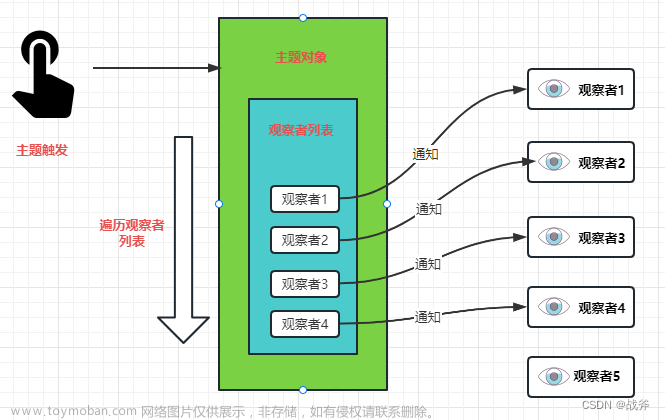介绍
Spring的监听器也可以说是一种观察者模式,它能实现事件与事件监听者直接的解耦,在Spring中监听器的实现主要有一下重要组件:
- ApplicationListener:事件监听者,观察者;
- ApplicationEvent:Spring 事件,记录事件源、事件内容、时间等数据;
- 有些场景事件主体主要是String或基本类型,4.2版本之后,不再强制要求继承ApplicationEvent,非ApplicationEvent子类的对象将被包装成PayloadApplicationEvent
- @EventListener:除了实现ApplicationListener接口注册监听器,也可以使用注解的方式
- ApplicationEventPublisher:发布事件;
事件监听4种方式
springboot进行事件监听有四种方式:
- 手工向ApplicationContext中添加监听器
- 使用注解将监听器装载入spring容器
- 在application.properties中配置监听器
- 通过@EventListener注解实现事件监听
讲到事件监听,这里我们说下自定义事件和自定义监听器类的实现方式:
-
自定义事件:继承自
ApplicationEvent抽象类,然后定义自己的构造器 -
自定义监听:实现
ApplicationListener<T>接口,然后实现onApplicationEvent方法。注意:该接口的实现类必须放到IOC容器中,否者不会起作用。
自定义事件
import org.springframework.context.ApplicationEvent;
/**
* created at 2023/4/18 10:43
*
* @author somnuszpli
*/
public class MyEvent extends ApplicationEvent {
private Long id;
private String name;
public MyEvent(Long id, String name) {
super(id);
this.name = name;
}
public Long getId() {
return id;
}
public void setId(Long id) {
this.id = id;
}
public String getName() {
return name;
}
public void setName(String name) {
this.name = name;
}
}
发布事件
import org.springframework.beans.factory.annotation.Autowired;
import org.springframework.context.ApplicationEventPublisher;
import org.springframework.stereotype.Component;
/**
* created at 2023/4/18 10:52
*
* @author somnuszpli
*/
@Component
public class MyEventPublisher {
@Autowired
private ApplicationEventPublisher applicationEventPublisher;
public void publishEvent(Long id, String name) {
MyEvent event = new MyEvent(id,name);
applicationEventPublisher.publishEvent(event);
}
}
1. 手工向ApplicationContext中添加监听器
首先创建MyListener1类
public class MyListener1 implements ApplicationListener<MyEvent>{
Logger logger = Logger.getLogger(MyListener1.class);
public void onApplicationEvent(MyEvent event){
logger.info(String.format("%s监听到事件源:%s.", MyListener1.class.getName(), event.getSource()));
}
}
然后在springboot应用启动类中获取ConfigurableApplicationContext上下文,装载监听
@SpringBootApplication
public class LisenterApplication{
public static void main(String[] args){
ConfigurableApplicationContext context = SpringApplication.run(LisenterApplication.class, args);
//装载监听
context.addApplicationListener(new MyListener1());
}
}
2. 使用注解将监听器装载入spring容器
创建MyListener2类,并使用@Component注解将该类装载入spring容器中
@Component
public class MyListener2 implements ApplicationListener<MyEvent>{
Logger logger = Logger.getLogger(MyListener2.class);
public void onApplicationEvent(MyEvent event){
logger.info(String.format("%s监听到事件源:%s.", MyListener2.class.getName(), event.getSource()));
}
}
3. 在application.properties中配置监听器
首先创建MyListener3类
public class MyListener3 implements ApplicationListener<MyEvent>{
Logger logger = Logger.getLogger(MyListener3.class);
public void onApplicationEvent(MyEvent event){
logger.info(String.format("%s监听到事件源:%s.", MyListener3.class.getName(), event.getSource()));
}
}
然后在application.properties中配置监听
context.listener.classes=com.listener.MyListener3
4. 通过@EventListener注解实现事件监听
创建MyListener4类,该类无需实现ApplicationListener接口,使用@EventListener装饰具体方法
@Component
public class MyListener4{
Logger logger = Logger.getLogger(MyListener4.class);
// @EventListener 注解支持根据Event参数类型进行匹配
@EventListener
public void listener(MyEvent event){
logger.info(String.format("%s监听到事件源:%s.", MyListener4.class.getName(), event.getSource()));
}
}
PayloadApplicationEvent
有些时候我们事件传递的对象是一些简单的对象,比如一个字符串,不想继承ApplicationEvent对象,可以使用PayloadApplicationEvent文章来源:https://www.toymoban.com/news/detail-485096.html
@Component
public class PayloadApplicationListener implements ApplicationListener<PayloadApplicationEvent<String>> {
@Override
public void onApplicationEvent(PayloadApplicationEvent<String> event) {
System.out.println(event.getPayload());
}
}
public static void main(String[] args) {
ApplicationContext applicationContext = new AnnotationConfigApplicationContext(AppConfig.class);
//applicationContext.publishEvent(new InitializePost(applicationContext, "Y"));
applicationContext.publishEvent("hello world");
//applicationContext.publishEvent(new C());
}
运行结果文章来源地址https://www.toymoban.com/news/detail-485096.html
hello world
到了这里,关于SpringBoot 监听器的文章就介绍完了。如果您还想了解更多内容,请在右上角搜索TOY模板网以前的文章或继续浏览下面的相关文章,希望大家以后多多支持TOY模板网!












